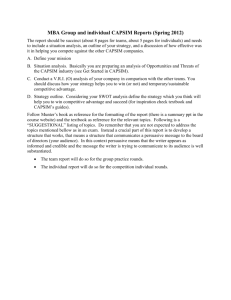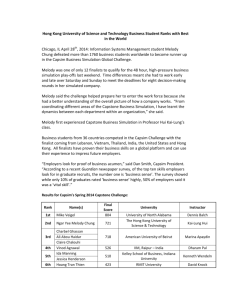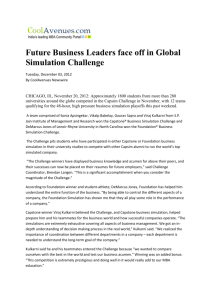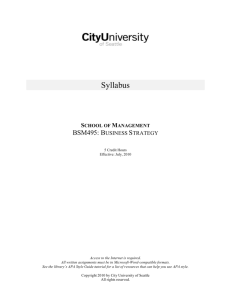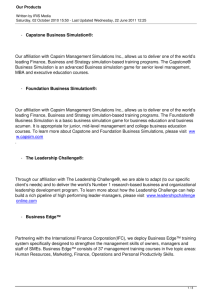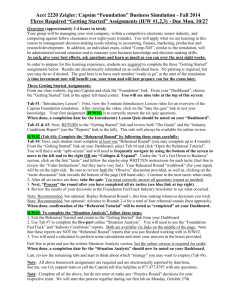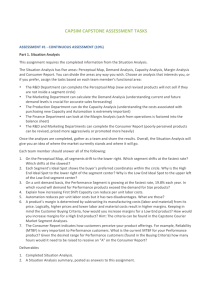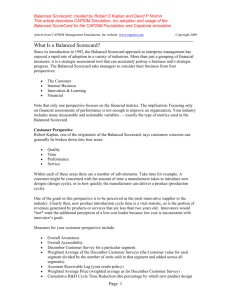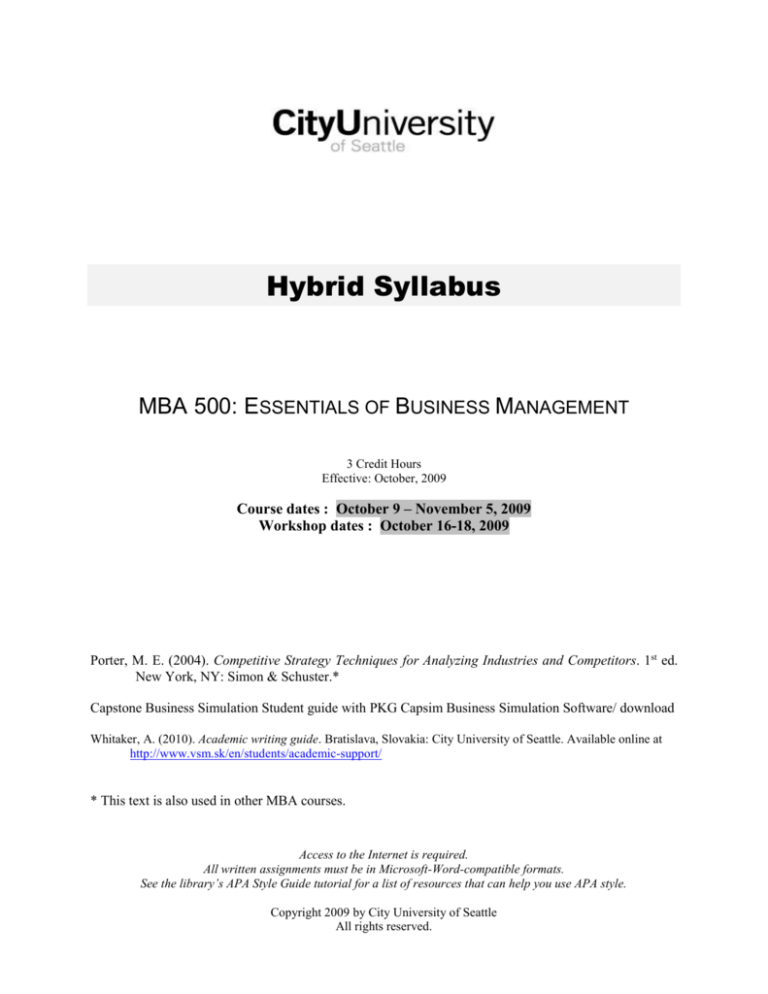
Hybrid Syllabus
MBA 500: ESSENTIALS OF BUSINESS MANAGEMENT
3 Credit Hours
Effective: October, 2009
Course dates : October 9 – November 5, 2009
Workshop dates : October 16-18, 2009
Porter, M. E. (2004). Competitive Strategy Techniques for Analyzing Industries and Competitors. 1st ed.
New York, NY: Simon & Schuster.*
Capstone Business Simulation Student guide with PKG Capsim Business Simulation Software/ download
Whitaker, A. (2010). Academic writing guide. Bratislava, Slovakia: City University of Seattle. Available online at
http://www.vsm.sk/en/students/academic-support/
* This text is also used in other MBA courses.
Access to the Internet is required.
All written assignments must be in Microsoft-Word-compatible formats.
See the library’s APA Style Guide tutorial for a list of resources that can help you use APA style.
Copyright 2009 by City University of Seattle
All rights reserved.
MBA 500: ESSENTIALS OF BUSINESS MANAGEMENT
FACULTY
Faculty Name: Marvee L. Marr
Contact Information: mmarr@vsm.sk
COURSE DESCRIPTION
Successful managers need to understand the fundamentals of business practices within a global context.
This course will introduce students to the overall MBA program and the strategies required in preparing a
comprehensive and viable business plan. Students will also practice business decision-making through the
use of simulations, and practical, analytical, and conceptual foundations in team-based learning. Learning
how to find relevant data through the use of credible sources will be a main focus of this course, as well
as how to effectively communicate in writing.
COURSE RESOURCES
Required and recommended resources to complete coursework and assignments are listed on the
My.CityU portal at Library>Resources by Course.
CITYU LEARNING GOALS
This course supports the following City University learning goals:
Professional Competency
Strong Communication and Interpersonal Skills
Critical Thinking
PROGRAM CONTEXT
This course begins the MBA program. It will lay the groundwork for subsequent MBA courses. Many of
the assignments completed in this course will be revisited as the program progresses. This course
contributes to the following end-of-program outcomes:
Communicate effectively both orally and in writing with internal and external stakeholders;
Leverage managerial effectiveness through recognition of individual strengths, values and business
philosophy;
Capitalize on business opportunities in a rapidly changing environment by thinking critically and
applying quantitative procedures and tools;
Build, lead and participate in productive and diverse teams.
Throughout the MBA program, you will be expected to maintain an electronic portfolio of all major
assignments from each course, either in a folder or removable disk drive dedicated solely to this purpose.
Be sure to keep back up copies of all your portfolio components. The E-portfolio will enable you to
MBA 500
Page 2
Eff: 10/09
reflect back on your previous work. It will also become a valuable tool for you to use in presenting your
work to potential employers to demonstrate how you applied your leadership skills and abilities to devise
strategies, accomplish goals, and work in team environments.
COURSE OUTCOMES
After completing this course, you will be able to:
Demonstrate effective team participation;
Analyze personal business strengths and weaknesses, and team function;
Given participation in a business simulation, articulate gaps in business knowledge, MBA
program goals and professional goals;
Implement business strategy;
Document strategic decision-making;
Using effective research strategies and research business ideas.
CORE CONCEPTS, KNOWLEDGE, AND SKILLS
The course will cover the following concepts and topics:
Information literacy;
Team functioning;
Jungian types;
Self-analysis;
Performance criteria;
Company structure and functions;
Documentation methods;
Components of a business plan proposal.
OVERVIEW OF COURSE GRADING
The grade you receive for the course will be derived using City University of Seattle’s decimal grading
system, based on the following:
Overview of Required Assignments
% of Final Grade
Weekly Online Discussion Board Postings, assigned by
instructor
Capsim Introductory Lessons and Quiz, Rehearsal
Simulation Rounds (at least two rounds), and Situation
Analysis
Porter’s Company Competitive Analysis
Capsim Team Situation Analysis & Strategy Report
Capsim Team Competition Rounds 1 & 2
20 %
TOTAL
100%
SPECIFICS OF COURSE ASSIGNMENTS
MBA 500
Page 3
Eff: 10/09
10 %
30 %
20 %
20 %
Your instructor will provide grading rubrics that will provide more detail as to how this assignment will
be graded.
Weekly Online Discussion Board Postings, assigned by instructor
Components
% of Grade
Appropriateness and quality of the response
Quantity of the responses
50%
50%
TOTAL
100%
Capsim Introductory Lessons and Quiz, Rehearsal Simulation Rounds (at least four rounds), and Situation
Analysis
Students will register at Capsim.com to complete this assignment. Once students register and receive
their student identification from Capsim, and industry number from their instructor, students are to
complete their introductory lessons and quiz in the Capsim Simulation established by their instructor.
Completion of the introductory lessons and quiz will lead the students directly into the Rehearsal
Simulations Rounds. Students must complete at least four rounds of simulation, but may due more (no
more than eight). Completion of the Rehearsal Simulation Rounds will lead students in completing their
Situational Analysis. The Situational Analysis is to be prepared and turned in to the instructor for
grading. The instructor can go to Capsim.com to confirm whether students completed the lessons, quiz
and rehearsal rounds.
Components
% of Grade
Completion confirmation of lessons/quizzes from Capsim
Completion confirmation of individual rehearsal rounds (at least 4)
Logically support recommendations and conclusions of analysis
30%
40%
30%
TOTAL
100%
Porter-Company Competitive Analysis
The fundamental assumption of this assignment is that the profit potential of any firm is a function of: (1)
the industries it operates in; and (2) the competitors it opposes. Therefore to enhance profits, executive
management must understand the industry structure and competition. The profits within an industry are
affected by a wide range of influences, including the macroeconomic environment, cost and demand
structures of the industry, technological change and government regulation. Competitive moves and
responses of incumbents also affect firm profits. Actions taken by firms to improve competitive position
engender responses by other firms, and the expected sequence of actions and responses must be
understood to develop an effective strategy. Reactions of rivals will depend on their goals or intent,
beliefs, relative resource positions and past actions. Thus, the approach to studying the dynamics of
industry structure and competitors is to focus on the key characteristics of industry structure and the
individual competitive moves and countermoves by the competitive players.
Using the components of a competitive analysis Figure 3-1 in the Porter’s text book (page 49), students
select a primary company in an industry that they have interest and/or are familiar. Students analyze and
MBA 500
Page 4
Eff: 10/09
contrast the competitive strategy of primary company and the other two competitors’ strategy. Students
then develop a competitive profile for the primary company and the two other companies in the industry
using the Porter competitor analysis criteria.
Next, analyze and contrast the competitive strategy of the primary company with the other 2 competitors’
strategy then answer the following questions:
What is the primary company’s current competitive strategy (be specific)?
What are the two competitors doing to improve their current competitive position?
What likely moves or strategy shifts will the two competitors make?
Where is the primary company most vulnerable?
Where are the two competitors most vulnerable?
What competitive moves by the two competitors will provoke the greatest and most effective
retaliation by the primary company?
7. Would you recommend the continuation or modification of the primary company’s current
strategy (support your rationale with specifics)?
1.
2.
3.
4.
5.
6.
Porter Competitor Analysis Criteria:
Estimated overall business strength:
Market share (percent, rank)
Market share trend (five years)
Financial strengths
Profitability
Management
Technology position
Other key strengths/limitations (e.g., production cost advantages)
Marketing strategy (assessment of key strengths and limitations):
Competitive strategy (Porter’s)
Market strategy
Distribution strategy
Recent offensive or defensive competitive moves
Components
% of Grade
Clarity of expression
Integration of course concepts, where relevant
Completeness of analysis
Logically supported conclusions and recommendations
Grammar, spelling, punctuation, and syntax (including proper APA
citation of throughout paper in for references)
15%
20%
30%
25%
10%
TOTAL
100%
Capsim Team Situation Analysis & Strategy Report
MBA 500
Page 5
Eff: 10/09
Once students have selected teams, and have begun their Capsim Practice Rounds, teams are to submit a
paper to their instructor, outlining their Situational Analysis and current strategy for the Capsim Practice
Rounds. The paper should be no more than two pages in length, detailing clarity, integration of course
concepts, a completeness of analysis and logically supported conclusions and recommendations.
Components
% of Grade
Clarity of expression
Integration of course concepts, as appropriate
Completeness of analysis
Logically supported conclusions and recommendations
Grammar, spelling, punctuation, and syntax (including proper APA)
references support, if applicable
15%
20%
30%
25%
TOTAL
100%
10%
Capsim Team Competition Rounds 1 & 2
Students are to complete Capsim Competition Rounds 1 & 2 on their assigned teams. Once students on
their assigned teams have completed these Competition Rounds, the student teams are to report out to the
class regarding their results for Capsim Competition Rounds 1 & 2. The synthesis of the reporting will be
centered on their performance with regard to their Capsim team financial condition, internal business
processes, customer focus, and learning and growth.
Components
% of Grade
Financial: Analysis of profitability, leverage, stock price
Internal Business Process: Analysis of ranks, among other measures,
contribution margin, plant utilization and days of working capital
Customer: Analysis of company’s product line, buying criteria
satisfaction, awareness, and accessibility levels
Learning and Growth: Employee productivity analysis
25%
25%
TOTAL
100%
COURSE POLICIES
MBA 500
Page 6
Eff: 10/09
25%
25%
This document provides an overview of the course foundation elements, assignments, schedules, and
activities. For information about general, City University of Seattle policies, please see the City
University of Seattle catalog. If you have additional questions about the course, please contact your
instructor.
Late Assignments
Students are expected to meet submission requirements for assignments in a timely manner. Evaluation
includes an assessment of timeliness. Late assignments jeopardize your learning, and may also penalize
your classmates as most assignments will not be returned to students until all students have submitted
their work. Late submission of assignments may be penalized up to 50% of the grade per week. Your
instructor will provide additional details.
Quizzes, exams, and comprehensive assessments must be taken at the scheduled times. Any absences or
late submissions must be approved by your instructor before the scheduled assessment date. Not
completing a quiz, exam, or comprehensive assessment in a timely manner will result in a grade of zero
unless a student has been preapproved by the instructor to complete the assessment at an alternative time.
Participation
Whether in class, online, or in a mixed mode setting, students will be graded on their participation in
classroom discussions; their ability to present, explain, or defend alternative viewpoints; and the degree to
which they have mastered the concepts and principles addressed in this course. Written work will be
assessed not only on relevance to the subject presented, but also on adherence to good written form and
professional presentation.
Students are expected to be actively engaged in all discussions as well as other activities. Active
engagement means contributing substantive, thoughtful and reflective responses. For online classes,
students must post their initial responses during the first three days of the week, and their responses to
other students’ postings during the last four days of the week.
Professional Writing
Assignments require error-free writing that uses standard English conventions and logical flow of
organization to address topics clearly, completely, and concisely. CityU requires the use of APA style.
UNIVERSITY POLICIES
You are responsible for understanding and adhering to all of City University of Seattle’s academic
policies. The most current versions of these policies can be found in the University Catalog that is linked
from the CityU Web site.
Scholastic Honesty
Scholastic honesty in students requires the pursuit of scholarly activity that is free from fraud, deception
and unauthorized collaboration with other individuals. You are responsible for understanding CityU’s
policy on scholastic honesty and adhering to its standards in meeting all course requirements. A complete
copy of this policy can be found in the University Catalog in the section titled Scholastic Honesty under
Student Rights & Responsibilities.
MBA 500
Page 7
Eff: 10/09
Attendance
Students taking courses in any format at the University are expected to be diligent in their studies and to
attend class regularly. A student must attend at least 70 % of the inclass seminar portion of the course to
be able to receive a passing grade.
Regular class attendance is important in achieving learning outcomes in the course and may be a valid
consideration in determining the final grade. For classes where a physical presence is required, a student
has attended if s/he is present at any time during the class session. For online classes, a student has
attended if s/he has posted or submitted an assignment. A complete copy of this policy can be found in
the University Catalog in the section titled Attendance Policy for Mixed Mode, Online and
Correspondence Courses.
Course Policies
-No late work will be given a grade
-minimum 70% attendance manadatory
-No make-up quizzes or exams
-Please respect the classroom, face to face and online, your peers and the instructor
SUPPORT SERVICES
Disability Resources
If you are a student with a disability and you require an accommodation, please contact administration as
soon as possible. For additional information, please see the section in the University Catalog titled
Students with Special Needs under Student Rights & Responsibilities.
Library Services
In order to help you succeed in this course, you have access to library services and resources 24 hours a
day, seven days a week. CityU librarians can help you formulate search strategies and locate materials
that are relevant to your coursework. For help, contact a CityU librarian through the Ask a Librarian
service. To find library resources, click on the Library link in the My.CityU portal.
Smarthinking
As a CityU student, you have access to 10 free hours of online tutoring offered through Smarthinking,
including writing support, from certified tutors 24 hours a day, seven days a week. Contact CityU’s
Student Support Center at info@cityu.edu to request your user name and password.
MBA 500
Page 8
Eff: 10/09
COURSE SCHEDULE : PLEASE NOTE-NO LATE WORK IS ACCEPTED,
SO PLAN YOUR TIME ACCORDINGLY. SCHEDULE SUBJECT TO
CHANGES.
COURSE
SESSION/DATE
1
October 9-15
2
Friday, Oct 16
3
Saturday, Oct 17
5
Sunday, Oct 18
MODULE(S), TOPICS AND
ASSIGNMENTS
Introduction to the MBA Program, MBA500
Course, Assignments, Teams and Teamwork,
Linkage of Porter text to Capsim, and Capsim
Business Simulation
Teams will be formed and start working together.
Coverage of team assignments.
Capsim and team and strategy topics linked to
assigned readings.
Explanation of Capsim, include a step-by-step
explanation of the simulation and how it works.
DUE: Capsim Introductory Lessons and Quiz,
Rehearsal Simulation Rounds (at least four
rounds), and Situation Analysis (as an
individual) (Due by midnight Oct 15)
Coverage of BRS Business Planning Software
Capsim six strategies and Porter’s Generic
Competitive Strategies
Capsim Practice Round 1 and company
performance measures
READINGS
Register for Capsim at Capsim.com
and become familiar with materials
located on the “Getting Started”
page.
Read Capsim Student Guide and
(Online) Manager’s Guide at
Capsim.com
Porter, Chapter 1
The Manager Guide’s Six Strategies
at Capsim.com
Coverage of BRS Business Planning Software
Capsim six strategies and Porter’s Generic
Competitive Strategies
Capsim Practice Round 1 and company
performance measures
Coverage of making strategic business decisions as
a team and business planning principles.
Importance of knowing own strengths, weaknesses
and preferences
Porter, Chapter 2
Cover Porter’s Market Signals
Basic decision-making principles in Capsim
Capsim Practice Round 1 results.
Administer C.A.T. – class evaluation
Porter, Chapter 4
Porter, Chapter 5
MBA 500
Page 9
Eff: 10/09
Porter, Chap 3
Cover scope of Interview Section only of the BRS
Business Planning Software.
Business planning process and role of the business
plan in the MBA Program.
Discuss Porter’s competitive moves, team situation
analysis and strategy reports
6
Online week
Oct 19-25
Capsim Simulation Rounds
DUE: Capsim Team Situation Analysis &
Strategy Report (by midnight Oct 25.)
DUE: Online discussion
7
Online week
Oct 26- Nov 1
DUE: Capism Team Competition Rounds 1 & 2
DUE: Online discussion (by midnight Nov. 1
Capism Simulation Rounds
8
Online Week
Nov 2-5
Due: Porter’s Company Competitive Analysis
(by midnight Nov. 5)
DUE: Online discussion
NO FINAL
Capsim Business Simulations
Rounds
MBA 500
Page 10
Eff: 10/09

